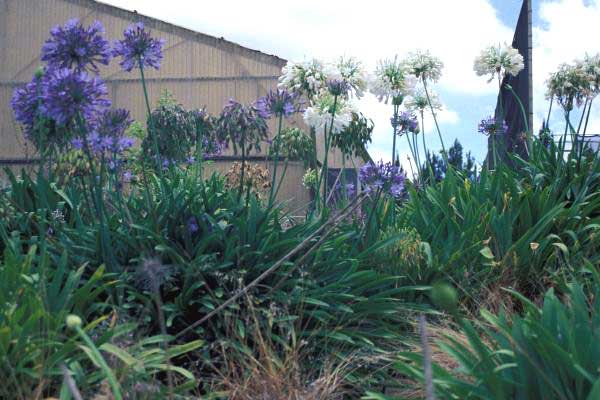
Agapanthus praecox
Classification System: APG IV
Superregnum: Eukaryota
Regnum: Plantae
Cladus: Angiosperms
Cladus: Monocots
Ordo: Asparagales
Familia: Amaryllidaceae
Subfamilia: Agapanthoideae
Genus: Agapanthus
Sectio: A. sect. Agapanthus
Species: Agapanthus praecox
Subspecies: A. p. subsp. minimus – A. p. subsp. orientalis – A. p. subsp. praecox
Name
Agapanthus praecox Willd. (1809)
Synonyms
Homotypic
Tulbaghia praecox (Willd.) Kuntze, Revis. Gen. Pl. 2: 718. 1891.
References
Willdenow, C.L.v. 1809. Enum. Pl. 1:353.
USDA, ARS, Germplasm Resources Information Network. Agapanthus praecox in the Germplasm Resources Information Network (GRIN), U.S. Department of Agriculture Agricultural Research Service. Accessed: 07-Oct-06.
Vernacular names
English: Common Agapanthus, Blue Lily, African Lily, Lily of the Nile
suomi: Tarhasinisarja
Agapanthus praecox (common agapanthus,[1] blue lily,[1] African lily,[2] or lily of the Nile[3]) is a popular garden plant around the world, especially in Mediterranean climates.[4] It is native to the Kwa-Zulu Natal and Western Cape provinces of South Africa. Local names include agapant, bloulelie, isicakathi and ubani.[1] Most of the cultivated plants of the genus Agapanthus are hybrids or cultivars of this species. It is divided into three subspecies: subsp.praecox, subsp. orientalis and subsp. minimus.[1]
Description
Flowering clumps
Agapanthus praecox is a variable species with open-faced flowers. It is a perennial plant that can survive up to 75 years. Its evergreen leaves are 2 cm wide and 50 cm long. Its inflorescence is in umbel. The flowers of the agapanthus are blue, purple or white and bloom from late spring to summer. They give capsules filled with fine black seeds (to be kept cool in sand until sowing). Its stem reaches one meter high. Its roots are very powerful and can break concrete.[1]
Subspecies
Agapanthus praecox subsp. praecox
This subspecies occurs in the Eastern Cape province of South Africa. It usually grows to between 0.8 and 1 metre tall and has 10-11 leathery leaves. The blue flowers, appear from December to February.[1] These have perianth segments which are greater than 50 mm in length.[1]
Agapanthus praecox subsp. orientalis
This subspecies occurs in the Eastern Cape and southern KwaZulu-Natal. Although it is about the same height as subsp. praecox, it has up to 20 poisonous, strap-like leaves per plant which are arching and are not leathery.[1] These range in length from 20 to 70 cm long and 3 to 5 cm wide.[5] Flower colour ranges from blue to white.[1][3] Shiny black seeds are produced in three-sided capsules.[3] These have perianth segments which are less than 50 mm in length.[1]
Agapanthus praecox subsp. minimus
Occurring in the southeastern Western Cape and Eastern Cape, this subspecies is the smallest, ranging in height from 300 to 600 mm. It has a longer flowering season, from November to March. Flower colour includes white and various shades of blue.[1]
Cultivation
The plant prefers a well-drained soil, but supports a poor soil. Exposure to full sun is preferable, but it supports partial shade. It does not like to be moved. It can be multiplied by sowing (flowering under 3 to 4 years) or division of tufts. It tolerates drought once well installed, but watering is preferable in case of long dry periods. It overwinters as a stump and therefore completely disappears during the cold months. Contrary to popular belief, this species can withstand wind, frost and cold up to −15 °C provided that the strains are protected for the first two years with mulching.
Young shoots need to be protected from slugs and snails. A contribution of 2 or 3 handfuls of wood ash around the stump in the spring will push the gastropods a few days and make a good contribution of potash.[6]
Naturalisation
The species is naturalised in Australia,[3] New Zealand[7] and the Isles of Scilly.[8] It is reportedly naturalized in Madeira, the Canary Islands, Eritrea, Ethiopia, St. Helena, Norfolk Island, Mexico, Honduras, Costa Rica and Tristan da Cunha.[9]
Agapanthus praecox subsp. orientalis is highly regarded for being tough in sun and heat, long-flowering, and is a favourite for many councils in Australia for the landscaping of roads and other public areas which do not get watered. The plant is still widely planted but in some areas it is considered a weed, and planting has been discontinued,[10] although it is not generally regarded as highly invasive.
References
"Agapanthus praecox Willd". PlantZAfrica.com. South African National Biodiversity Institute. Archived from the original on 2004-03-05. Retrieved 2008-07-20.
"Agapanthus praecox". Germplasm Resources Information Network (GRIN). Agricultural Research Service (ARS), United States Department of Agriculture (USDA). Retrieved 2008-07-20.
"Agapanthus - Weeds of Blue Mountains Bushland". Archived from the original on 20 July 2008. Retrieved 2008-07-20.
"In Bloom - Agapanthus". Archived from the original on 2017-01-18. Retrieved 2016-12-31.
"Agapanthus praecox subsp. orientalis (F.M.Leight.) F.M.Leight". PlantNET - New South Wales Flora Online. Royal Botanic Gardens & Domain Trust, Sydney Australia. Archived from the original on 15 August 2008. Retrieved 2008-07-20.
Jean Trudel, Gardens and scenery: summer flowers, Saint-Laurent (Quebec), Book-Loisirs Ltée,1984, 65 p. ISBN 2-89210-229-4
"Agapanthus praecox". Weeds Index. Environment Bay of Plenty. Archived from the original on 2008-06-21. Retrieved 2008-07-20.
"Weird Weeds of Scilly" (PDF). The Islander. Archived from the original (PDF) on 2008-07-05. Retrieved 2008-07-20.
Kew World Checklist of Selected Plant Families
"Councils Halt Cultivation of Agapanthus Plants". Archived from the original on 2012-06-11. Retrieved 2012-12-23.
Retrieved from "http://en.wikipedia.org/"
All text is available under the terms of the GNU Free Documentation License

